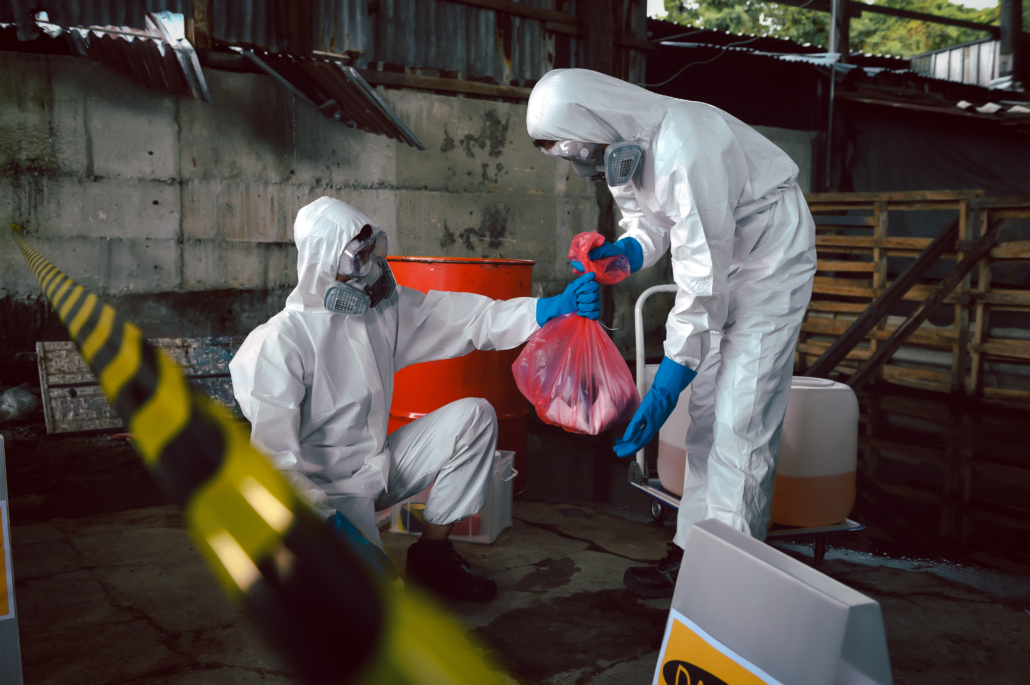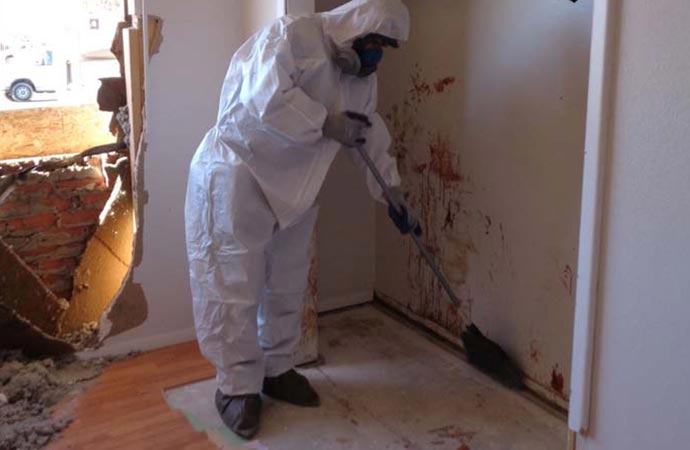Flood Damage Restoration: Quick and Reliable Recovery for Your Home
Flood Damage Restoration: Quick and Reliable Recovery for Your Home
Blog Article
Expert Biohazard Cleansing and Purification for Blood, Bodily Fluids, and Hazardous Products
The potential wellness dangers associated with exposure to biohazards emphasize the essential demand for precise handling and extensive cleanup. As we navigate the intricate landscape of biohazard cleanup, comprehending the subtleties of regulations, compliance, and the customized devices at play becomes imperative in ensuring a complete and secure purification process.
Wellness Dangers of Biohazard Exposure
Exposure to biohazards poses significant health and wellness dangers that can cause extreme effects for individuals and areas alike. Biohazards encompass a vast array of organic materials, consisting of blood, physical liquids, mold, bacteria, viruses, and various other potentially contagious materials. When individuals enter contact with these biohazards, whether via crashes, inappropriate handling, or ecological direct exposure, they face the danger of contracting major ailments or conditions.
Among the main health dangers related to biohazard exposure is the transmission of contagious diseases. Bloodborne pathogens such as HIV, liver disease B and C, and numerous microorganisms can be existing in biohazardous products, presenting a straight hazard to human health and wellness. Inhaling air-borne biohazards like mold and mildew spores or entering into contact with contaminated surface areas can additionally lead to respiratory system concerns, allergies, and various other adverse wellness impacts.
Additionally, biohazard exposure can have long-term health and wellness implications, with some conditions showing up years after the initial get in touch with (Blood Cleanup). Therefore, it is important to prioritize proper biohazard cleaning and decontamination to alleviate these health and wellness risks and make sure the safety and security of areas and individuals

Specialized Training for Biohazard Cleaning
When it comes to handling biohazard clean-up efficiently and securely, specialized training plays a fundamental duty in making sure correct decontamination procedures are followed. Biohazard clean-up needs particular knowledge and skills to efficiently mitigate threats linked with bloodborne pathogens, bodily liquids, and unsafe products. Experts trained in biohazard cleaning go through strenuous guideline on just how to safely manage, eliminate, and take care of biohazardous products to prevent contamination and direct exposure.
Specialized training for biohazard cleaning covers a variety of essential topics, including proper individual safety equipment (PPE) use, bloodborne pathogen awareness, purification techniques, and contaminated materials disposal procedures. Individuals educated in biohazard cleanup are outfitted with the needed knowledge to examine contamination degrees, determine prospective threats, and implement proper clean-up procedures in conformity with regulative criteria.
Constant training and education are vital in the field of biohazard cleaning to remain upgraded on the newest purification technologies, safety and security methods, and policies. By purchasing specialized training, biohazard cleaning professionals can successfully reply to emergency cleanup circumstances and secure both public health and the setting.
Importance of Proper Purification Techniques
Using correct decontamination strategies is crucial in biohazard cleaning to properly eliminate harmful products and reduce health and wellness dangers. Reliable decontamination not only makes sure the elimination of visible traces of blood, bodily liquids, and various other biohazards however additionally targets unnoticeable microorganisms that might position severe health threats otherwise appropriately removed. By adhering to stringent decontamination methods, trained professionals can considerably decrease the risk of direct exposure to hazardous microorganisms, viruses, and bacteria that might result in diseases or infections.
Correct decontamination strategies involve making use you could check here of specific devices and disinfectants that are particularly designed to neutralize biohazards efficiently. Thorough cleaning and disinfection of contaminated areas are vital to stop the spread of virus and make certain a secure atmosphere his comment is here for passengers. Furthermore, the proper disposal of biohazardous waste complying with purification treatments is important in stopping contamination of other surface areas or people.

Tools and Tools for Safe Cleanup
When dealing with blood, bodily liquids, or dangerous products, biohazard cleaning specialists depend on specialized gear to minimize direct exposure risks and completely decontaminate the afflicted area. In addition, biohazard cleaning packages containing disinfectants, absorptive products, and biohazard bags are utilized to securely consist of and get rid of of polluted things.
Advanced cleaning devices like hospital-grade disinfectants, HEPA-filtered vacuums, and misting makers are employed to sterilize surfaces and get rid of biohazards effectively. Specialized equipment such as sharps containers and biohazard waste disposal containers are made use of to securely handle sharp objects and biohazardous waste products. By making use of the right tools and tools, biohazard cleansing specialists can guarantee a complete cleaning procedure that focuses on safety and security and reduces health threats for both workers and occupants of the damaged area.
Rules and Conformity in Biohazard Cleaning
Correct adherence to guidelines and compliance requirements is critical in biohazard cleaning to ensure the safety and security of both personnel and the environment. Federal government agencies such as OSHA (Occupational Security and Health And Wellness Administration) and the EPA (Epa) have actually established certain guidelines for biohazard cleanup procedures to lessen health risks and ecological contamination. These regulations cover a variety of aspects consisting of the handling, transport, and disposal of biohazardous materials, along with the required training and safety tools needed for employees associated with the cleaning process.
Biohazard cleaning business must remain up-to-date with these policies to ensure that their procedures satisfy the required security requirements. Failure to abide by these laws can lead to severe effects, consisting of fines, lawful activity, and threatening the wellness of people and the environment. By following rigorous guidelines and compliance procedures, biohazard cleaning business can effectively alleviate dangers and ensure a secure and detailed clean-up process for all parties entailed.
Verdict
Finally, biohazard cleansing and purification does bleach clean up blood require specialized training, appropriate techniques, and adherence to policies. Exposure to blood, bodily liquids, and dangerous materials poses significant health dangers, making it crucial to utilize the appropriate tools and devices for safe cleaning. By following rigorous methods and standards, experts can efficiently alleviate the threats connected with biohazard exposure and ensure the safety and security of both themselves and others.
As we navigate the complex landscape of biohazard cleaning, comprehending the subtleties of guidelines, compliance, and the specific equipment at play comes to be essential in making certain a complete and secure purification process. (Blood Cleanup)
When it comes to handling biohazard cleanup efficiently and safely, specialized training plays a fundamental role in guaranteeing correct purification procedures are adhered to.Making use of appropriate decontamination strategies is vital in biohazard cleaning to successfully get rid of harmful products and minimize health risks. Furthermore, biohazard cleaning kits consisting of anti-bacterials, absorbent products, and biohazard bags are made use of to safely consist of and dispose of contaminated products.
Government agencies such as OSHA (Occupational Safety and Wellness Administration) and the EPA (Environmental Security Firm) have developed details guidelines for biohazard clean-up treatments to reduce wellness dangers and environmental contamination.
Report this page